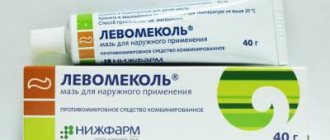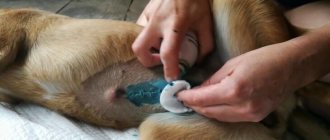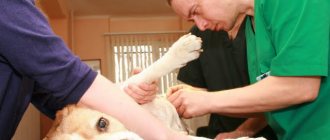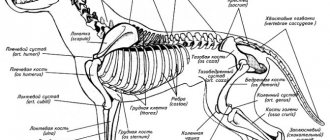Determining that your pet has a sore paw is not that difficult. The signs are clearly visible and known to everyone. What can the owner do? First, carefully examine the limb; secondly, try to find out the cause of the painful condition. If there are no open wounds, slowly feel the paw from bottom to top. The dog itself will tell you by whining where the problem arose.
Sometimes a growth or even a tumor is found on a dog's paw. The cause can be either injury or disease. If you find out why the dog’s paw is swollen and do not see a threat to the health and life of the animal, provide assistance yourself. If you have any doubts or the case is really complicated, seek help from a specialist.
Injuries
Limb injuries in active dogs are not uncommon. Experienced dog breeders always have first aid supplies in their first aid kit: hydrogen peroxide, tweezers, elastic bandage, brilliant green, tourniquet. But it would be better to prevent injury. Therefore, try to adhere to these rules:
- Do not walk your four-legged dog in vacant lots and abandoned construction sites.
- When walking, avoid places where you are likely to encounter aggressive animals.
- Keep your pet off leash near highways or railroads.
If the dog is injured, determine the severity by external signs and try to provide assistance.
Clinical manifestations and diagnosis
In the acute form of gastric volvulus, the pet’s health is in serious danger. The animal's behavior changes dramatically - the dog begins to whine and squeal, cannot stand on its paws, arches its back, and rubs its belly on the floor surface. The dog's abdomen swells, increases in size, is tense and sharply painful upon palpation. Side effects include frequent difficulty breathing, wheezing, dry cough, and heart rhythm disturbances. The pet refuses food and water, becomes lethargic and weak. If the cause of bloating is an infectious disease, enlargement of the lymph nodes is possible.
To clarify the diagnosis, you will have to undergo the following types of studies:
- General blood analysis.
- Analysis of stool for coprogram.
- Biochemical blood tests.
- Serological tests for the presence of antibodies to viruses and bacteria in the blood.
- X-ray of the abdominal cavity and chest.
- Ultrasound examination of the abdominal organs.
- Computed tomography or magnetic resonance imaging.
- Puncture of lymph nodes.
A gastric juice test may be needed to determine the amount of enzymes.
Bruises and sprains
In case of bruises and sprains, the dog tries not to stand on the sore paw, presses it, but does not allow it to be touched. Tumors do not appear immediately and do not have clear boundaries.
It is easy to remove a tumor from a bruise without damaging tissue. To do this, immobilize the dog and apply a cold compress to the sore spot for 20 to 30 minutes. If the skin is broken, first treat the wound with water peroxide and then apply ice.
Important! Do not use pain-relieving gels from your first aid kit when treating dogs. Many of them contain diclofenac. If the dog licks it, intestinal bleeding may occur.
When a ligament is sprained, the joints become swollen. The main condition: to ensure the immobility of the limb. This can be achieved by applying a splint.
Factors that provoke the appearance of edema
Below we will look at individual factors that provoke the appearance of edema. Some of them are “original”, while others have already been indirectly mentioned above.
Allergy and Quincke's edema
As we have already written, allergies and angioedema are one of the most common causes of swelling. Allergies develop to anything, at any time, and often the only visible sign is a skin rash and swelling.
The mechanism of development of the latter has already been described above. If the owner suspects the allergic origin of peripheral edema, the pet should be immediately taken to the veterinarian. With allergies, not only the paws, but also the lungs can swell. And this is already a deadly pathology.
Postoperative period
Swelling during the postoperative period is quite common and in most cases it is not dangerous. But! This only applies to situations where swelling lasts for more than two or three days. At this time, the body has not yet fully recovered, interruptions in the functioning of the kidneys are possible (they are already overloaded with removing drug residues), and traumatic swelling often develops at the site of surgical sutures.
Swelling after IV
As in the previous case, swelling after an IV is not considered something “criminal”. Again, only in cases where the swelling goes away quickly.
Their appearance is due to the appearance of additional fluid in the bloodstream, which the kidneys cannot quickly remove. Therefore, part of the liquid fraction of the blood again escapes into the surrounding tissues.
After a snake bite
But swelling after a snake bite is not a good sign. More precisely, swelling in this case indicates a snake bite with a hemolytic type of venom (vipers, rattlesnakes). This type of toxin decomposes the blood into its constituent elements; the walls of blood vessels are also affected, as a result of which the liquid part begins to effusion into the surrounding tissues.
Fractures and dislocations
If a dog's hind leg is swollen, and the animal does not stand on it, pulling it towards its stomach, then most likely there is a fracture or dislocation of the hip joint. For similar injuries to the forelimbs, before examining the paw, put a veterinary collar on the dog or secure the jaw with a bandage to prevent it from being bitten. Severe pain and fear can make even an obedient and kind dog restless and aggressive.
Try to calm your pet and carefully examine the limb. Creaking, clicking at the site of injury, and displacement of bones are the main signs of such injuries.
Your actions:
- limit the animal’s mobility, apply a splint (if the dog’s front paw is swollen, try to fix it with a bandage in a suspended state);
- apply ice to the sore spot;
- ensure transportation of the injured animal to the clinic.
You will need an x-ray and qualified assistance from a specialist.
Delay can only cause harm to your pet. After a few days, it will be much more difficult to straighten the limb, because the cartilage tissue of the joint will begin to scar and only surgery can correct the situation.
Treatment of various types of body edema at home
Whatever the edema, treatment procedures, medications, course of treatment should be prescribed by a doctor based on the results of clinical and laboratory tests.
Front and hind legs
For swelling of the front and hind legs, biochemical blood tests are necessary. There is no need to apply compresses, wraps, poultices, ice application and other procedures if the swelling is not caused by local exposure (frostbite, burns). If the swelling is caused by paresis or paralysis, if nerve conduction is disrupted, then the tissue will be renewed gradually.
In case of joint swelling, bruises, sprains, it is necessary to apply cold (only in the first 1-2 hours), a tight bandage and ensure rest.
Swelling of the head and muzzle: eyes, cheeks, nose, lips, tongue
Swelling of the head and muzzle: eyes, cheeks, nose, lips, tongue can occur due to allergic reactions. In this case, the animal can be given an injection of diphenhydramine, Tavegil or Suprastin. If the swelling is due to a bee or other insect sting, anoint the bite site with iodine and apply ice.
If the cause of edema is a mite that causes demodicosis, then it is impossible to do without an accurate diagnosis. If the diagnosis is confirmed, liniment “Demos”, drugs “Decta”, “Ivermect-spray” will be effective.
Necks
If your neck swells, you need to rush to the doctor, as disturbances in the respiratory system are possible. There is no point in applying treatment on your own. The best principle is to do no harm.
Outer ear
Swelling of the outer ear and pinna may be associated with insect bites. If such a case is isolated, then it is enough to treat the bite site with an alcohol tincture of iodine.
With otodectosis (ear mites) in a chronic form, there may also be a reaction and swelling. In this case, you should use Amidel-gel, Dekta, Amit.
Testicles, scrotum or loops
Inflammation of the testicle (orchitis) in a male dog will be manifested not only by swelling of the scrotum, but also by pain, increased local and general temperature. The dog will have difficulty moving its limbs. The process is very painful and to ease the course before a doctor’s examination, you can use analgesics and wipe the scrotum with camphor oil.
Swelling of the loop in a bitch is observed during sexual arousal and is considered an absolutely normal phenomenon.
If the vagina and vulva are ruptured during childbirth, severe swelling will occur. To prevent ruptures, it is necessary to introduce mucous substances when the birth canal is dry and not to begin obstetrics until the position of the puppies is corrected in case of pathological presentation or volvulus.
Belly
Swelling of the abdomen cannot be ignored. However, you don’t need to provide help yourself. A timely visit to the clinic and diagnostic tests will help to find out the cause of the occurrence.
Abdominal edema is especially dangerous if its appearance is due to unknown causes.
Tail
Tail swelling is a rare occurrence unless mechanical compression occurs. But the subcaudal space can suffer from swelling due to inflammation of the paraanal glands.
If the dog is predisposed to clogging of the glands, then it is necessary to carry out timely cleaning to avoid pathological phenomena. In case of primary inflammation, an urgent visit to a doctor is necessary to provide assistance.
Cuts and punctures, insect bites
The soles of your dog's paws can also become swollen. This usually happens if the animal cuts, punctures its paw, or steps on a wasp or bee. After removing the sting if necessary, wipe the bite site with a weak aqueous solution of vinegar and give your four-legged friend a tablet of suprastin or loratadine to relieve the allergic reaction.
Note! Dogs' skin is sensitive to iodine. Treating wounds and abrasions with iodine solution can cause burns.
A tumor caused by cuts or punctures will persist until the wound heals and the inflammatory process passes. Until then, the dog will tuck its paw and be afraid to step on it. For deep injuries, take your pet to a doctor.
First signs
When a dog's finger is broken, owners can immediately notice a change in the animal's behavior. Fractures are always accompanied by severe pain, the animal begins to whine, limp, and take care of the damaged paw. The dog can walk on the injured paw, but will not be able to put all the weight on it.
As with any fracture, swelling and severe pain appear at the site of injury. If you carefully palpate the fracture site, you will notice a thickening of the finger relative to the others, pain, and increased temperature in this place.
Diseases
Swelling of the paw or tumor is a consequence of the development of any disease not associated with external causes. Tumors can have different shapes, densities, and locations. You can get rid of them only by curing the underlying disease.
Therefore, if your dog has a swollen paw and you are sure that there were no injuries, you should look for the disease. Most often, animals develop edema and tumors due to the following health problems:
- vascular diseases;
- articular hygroma (a formation that occurs more often in the elbow joints, in which fluid accumulates);
- benign and malignant neoplasms (tumor in the form of a lump, painless, with clearly defined edges);
- pathologies of the kidneys and liver with impaired lymph outflow (tumors are soft, do not have clear boundaries, swelling is stronger in the lower part of the limb);
- arthritis, arthrosis, ingrown claws;
- pododermatitis (an inflammatory process associated with decreased immunity and manifested by swelling of the fingertips and the spaces between them);
- vitamin deficiency and lack of essential microelements in food (joints become swollen, more common in German shepherds);
- allergies to dust or chemicals in the soil.
Only in a veterinary clinic will you be able to find out the exact cause and choose an effective treatment after a thorough examination and examination.
Causes of edema in dogs
Edema occurs due to the sweating of the liquid fraction of blood with high vascular permeability.
This phenomenon can occur when:
- traumatic damage to capillaries, veins, nerve endings, lymphatic vessels (tissue compression, compression, loss of integrity upon impact, bruise);
- thermal effects on tissue (frostbite, burns);
- microbiological effects (introduction of bacteria, viruses, fungi);
- parasitological effects (bite of a tick causing demodicosis, larvae of the Wohlfarth fly causing myiasis);
- exposure to an allergen or toxin (snake bite, insect bite);
- physiological (swelling of the loop in bitches during estrus).
The causes of edema in dogs can be different. However, they all lead to disruption of the osmotic pressure inside the cells, which causes tissue swelling, which the owner observes as edema.
Due to the dog's fur, swelling is often not visible. To diagnose, they resort to palpation methods. By palpating peripheral organs, you can feel tissue swelling.
First aid for a dog with swelling: what the owner can do
To ensure that the consequences of swelling are not so serious, high-quality first aid should be provided to the dog for swelling. But! We immediately warn breeders: if there is a suspicion of the allergic nature of the pathology, and even more so in cases where the pet has Quincke's edema or anaphylaxis, there is no need to waste time and try to help the pet on your own. In such situations, you should immediately call a veterinarian. In milder cases, self-help is still possible.
To do this, the owner needs to do the following:
- Regardless of the etiology of edema, the pet should be given complete rest. This is especially important when your pet’s paws are injured. In such cases, he should not run or even walk a lot.
- The application of a warm compress may be recommended, but not in the first hours, and only after mandatory consultation with a veterinarian. It must be remembered that slight swelling can be a sign of an abscess or cellulitis, so heat can make the animal much worse.
- If the animal’s well-being allows it, it is also not given anything to drink during the first hours. Excess fluid will only contribute to the further development of edema.
- The pet should be placed in a well-ventilated area at room temperature. If the swelling is of allergic origin, even such a simple measure will help improve the dog’s condition.
Unfortunately, in other cases you won’t be able to do something on your own.










